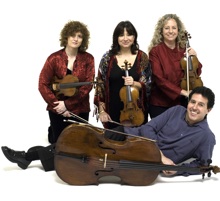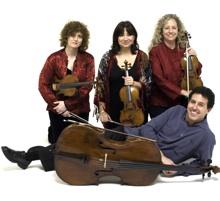
Often choosing lesser-known pieces and focusing on American composers is an Ives Quartet tradition, according to cellist Stephen Harrison. In part, he admits, “It’s selfish. We’re doing things we enjoy.” Each piece in this program was selected for a specific reason. The Mozart quartet is a piece the players knew, but had never played together before. During rehearsals, Harrison says they’ve become more and more enamored of it. Porter’s ninth quartet, his last composition for string quartet, is one they’re planning to record. “We need to play it. It’s also interesting because, unlike his first seven quartets, it doesn’t have a rhythm of fast, slow, fast. It still emphasizes Porter’s unique rhythmic style, though.” As for the Mendelssohn quartet, it was chosen in part because it isn’t played much, and also because it has a fleetness and a kinship to the Mozart piece that appeals to the group.
The Silicon Valley–based quartet is named after composer Charles Ives, who at the beginning of the 20th century moved away from musical traditions to compose pieces that are essentially American. Ives is noted for his mix of styles, broad-ranging approach, and strong individuality. The members of the quartet (in addition to Harrison, they are violinist Bettina Mussumeli, violinist Susan Freier, and violist Jodi Levitz) consider their mission to continue this innovation and type of musical adventure. As Harrison puts it, “We’re not doing what’s expected but instead marching (as much as a string quartet can!) to our own drummer.”
The members of the quartet enjoy looking for the underplayed and unusual pieces, and bringing them to the attention of a wider audience. They’ve made a name for themselves for their unique sound and their interpretation of American composers, especially those pieces by Quincy Porter, whom Harrison calls “easily the most prolific American quartet composer,” and his golden period between the 1930s and 1950s.
An early arrival at either of the Quartet’s two concerts of this program (in San José and Palo Alto) will bring you the added bonus of a behind-the-scenes explanation from the artists themselves as to just why they chose each piece and how the pieces work together as a whole. If past performances are any indication, each concert will be a fun, thought-provoking evening.

